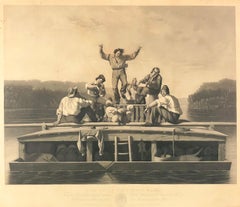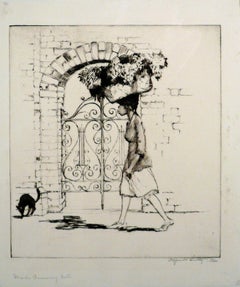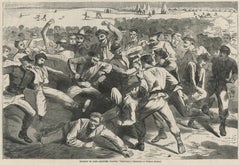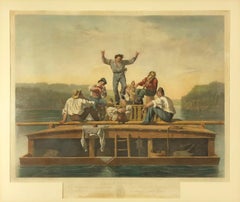George Caleb Bingham Art
George Caleb Bingham was born in Augusta County, Virginia in the Shenandoah River Valley on March 20, 1811. In 1819, as an eight-year-old, he moved to Boone's Lick, Missouri with his parents and grandfather who had been farmers and millers in the Shenandoah Valley near Rockingham, Virginia. As a child, he took every opportunity to escape supervision to travel to the river and watch the marine activity. His father died in 1823 when he was 12 years old. His mother had encouraged his artistic talent, but art lessons were not easily obtainable. To earn money, he apprenticed to a cabinet maker but became determined to become an artist. By 1835, he had a modest reputation as a frontier painter and successfully charged twenty dollars per portrait in St. Louis. “His portraits had become standard decorations in prosperous Missouri homes”, said Samuels about Bingham. In 1836, he moved to Natchez, Mississippi and there he had the same kind of career and was able to charge forty dollars per portrait. He remained largely self-taught until 1837 when he started using the proceeds from his portraiture and studied several months at the Pennsylvania Academy of the Fine Arts. Bingham credited Chester Harding as being the earliest and one of the most lasting influences on his work. Harding, a leading portraitist when Bingham was a young man, had a studio in Franklin, near Bingham's home town. In 1822, when Bingham was 10 years old, he watched Harding finish a portrait of Daniel Boone. Bingham recalled that watching Harding with the Boone portrait was a lasting inspiration and that it was the first time he had ever seen a painting in progress. Harding suggested to Bingham that he begin doing portraiture by finding subjects in the river men, which, of course, opened the subject matter that established fame and financial success for Bingham. He later painted two portraits of Boone. Bingham's portraits of Boone are not located, but one of them, a wood signboard for a hotel in Boonville circa 1828–30, showed a likeness of Boone in a buckskin dress with his gun and inscription Daniel Boone / Liberty. From 1840–44, Bingham was based in Washington DC where he painted portraits of prominent citizens, but he failed to achieve much recognition until he returned to Missouri in 1844 and began painting river genre works from a studio in St. Louis. Among the first notable paintings of his signature subject was Fur Traders Descending the Missouri in 1845. He later said that he learned much of his atmospheric style and classically balanced composition by copying paintings in collections in St. Louis and Philadelphia and that among his most admired painters were Thomas Cole, John Vanderlyn and William Sidney Mount. George Caleb Bingham became known for classically rendered western genre, especially Missouri and Mississippi River scenes of boatmen bringing cargo to the American West and politicians seeking to influence frontier life. One of his most famous river genre paintings was The Jolly Flatboatmen in 1846. The first version of this painting is in the Manoogian Collection at the National Gallery of Art. This work gained fame when it was exhibited in New York at the American Art Union, whose organizers made an engraving of 10,000 copies and distributed it to all of their members. Paintings such as Country Politician in 1849, County Election in 1852 and Stump Speaking in 1854 reflected Bingham's political interests. Between 1856–59, Bingham traveled back and forth to Düsseldorf, Germany, where he studied the work of genre painters. Some critics think these influences were negative on his work because, during that period, he abandoned the luminist style that had brought him so much public affirmation. Bingham was creative artistically and at the same time, he was running for state office. He was a member of the Whig party, founded in 1834 as a coalition opposed to Andrew Jackson, who was the US President. Bingham's close friend and influential Missouri Whig, James Sidney Rollins, drew him into politics. Bingham gave speeches for presidential candidate William Henry Harrison. In 1846, Bingham was elected to the state legislature, but the election was contested and Bingham lost the office. In 1862, he was appointed state treasurer and in 1875, Adjutant General. In 1872, he visited Colorado, where he did a painting of Pike's Peak, View of Pikes Peak, now in the Amon Carter Museum. In 1877, he accepted a professorship at the University of Missouri at Columbia, a position he held for only two years because he died in 1879.
Mid-19th Century American Realist George Caleb Bingham Art
Engraving
Mid-19th Century American Realist George Caleb Bingham Art
Engraving
Mid-19th Century American Realist George Caleb Bingham Art
Engraving
1930s American Realist George Caleb Bingham Art
Drypoint
1860s American Realist George Caleb Bingham Art
Engraving
1890s American Realist George Caleb Bingham Art
Drypoint
1930s American Realist George Caleb Bingham Art
Paper, Etching
1910s American Realist George Caleb Bingham Art
Lithograph
1940s American Realist George Caleb Bingham Art
Drypoint
Mid-20th Century American Realist George Caleb Bingham Art
Drypoint, Etching
21st Century and Contemporary American Realist George Caleb Bingham Art
Canvas, Giclée
1930s American Realist George Caleb Bingham Art
Drypoint
1930s American Realist George Caleb Bingham Art
Drypoint
1920s American Realist George Caleb Bingham Art
Drypoint, Etching
1860s American Realist George Caleb Bingham Art
Engraving
1840s Hudson River School George Caleb Bingham Art
Paper, Engraving
Mid-19th Century American Realist George Caleb Bingham Art
Mezzotint
Mid-19th Century American Realist George Caleb Bingham Art
Mezzotint






